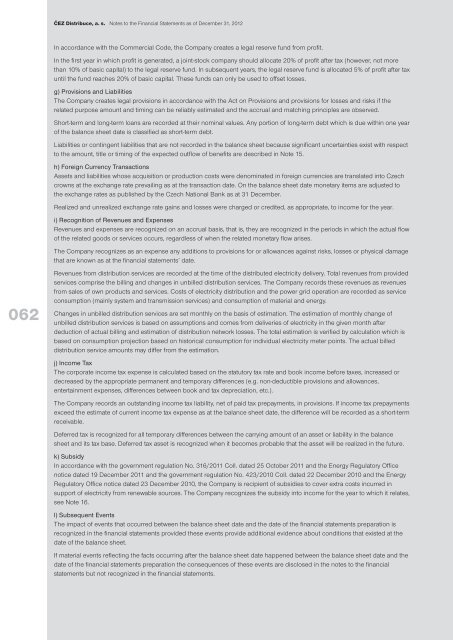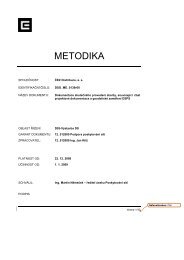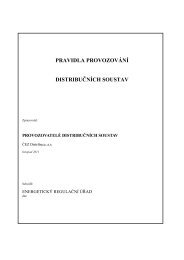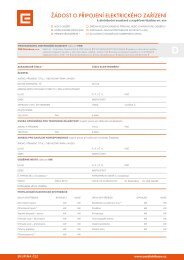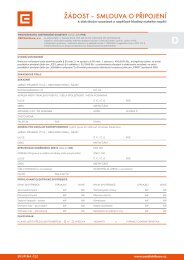012 - ÄEZ Distribuce
012 - ÄEZ Distribuce
012 - ÄEZ Distribuce
- No tags were found...
You also want an ePaper? Increase the reach of your titles
YUMPU automatically turns print PDFs into web optimized ePapers that Google loves.
ČEZ <strong>Distribuce</strong>, a. s. Notes to the Financial Statements as of December 31, 2<strong>012</strong><br />
In accordance with the Commercial Code, the Company creates a legal reserve fund from profit.<br />
In the first year in which profit is generated, a joint-stock company should allocate 20% of profit after tax (however, not more<br />
than 10% of basic capital) to the legal reserve fund. In subsequent years, the legal reserve fund is allocated 5% of profit after tax<br />
until the fund reaches 20% of basic capital. These funds can only be used to offset losses.<br />
g) Provisions and Liabilities<br />
The Company creates legal provisions in accordance with the Act on Provisions and provisions for losses and risks if the<br />
related purpose amount and timing can be reliably estimated and the accrual and matching principles are observed.<br />
Short-term and long-term loans are recorded at their nominal values. Any portion of long-term debt which is due within one year<br />
of the balance sheet date is classified as short-term debt.<br />
Liabilities or contingent liabilities that are not recorded in the balance sheet because significant uncertainties exist with respect<br />
to the amount, title or timing of the expected outflow of benefits are described in Note 15.<br />
h) Foreign Currency Transactions<br />
Assets and liabilities whose acquisition or production costs were denominated in foreign currencies are translated into Czech<br />
crowns at the exchange rate prevailing as at the transaction date. On the balance sheet date monetary items are adjusted to<br />
the exchange rates as published by the Czech National Bank as at 31 December.<br />
Realized and unrealized exchange rate gains and losses were charged or credited, as appropriate, to income for the year.<br />
i) Recognition of Revenues and Expenses<br />
Revenues and expenses are recognized on an accrual basis, that is, they are recognized in the periods in which the actual flow<br />
of the related goods or services occurs, regardless of when the related monetary flow arises.<br />
The Company recognizes as an expense any additions to provisions for or allowances against risks, losses or physical damage<br />
that are known as at the financial statements’ date.<br />
062<br />
Revenues from distribution services are recorded at the time of the distributed electricity delivery. Total revenues from provided<br />
services comprise the billing and changes in unbilled distribution services. The Company records these revenues as revenues<br />
from sales of own products and services. Costs of electricity distribution and the power grid operation are recorded as service<br />
consumption (mainly system and transmission services) and consumption of material and energy.<br />
Changes in unbilled distribution services are set monthly on the basis of estimation. The estimation of monthly change of<br />
unbilled distribution services is based on assumptions and comes from deliveries of electricity in the given month after<br />
deduction of actual billing and estimation of distribution network losses. The total estimation is verified by calculation which is<br />
based on consumption projection based on historical consumption for individual electricity meter points. The actual billed<br />
distribution service amounts may differ from the estimation.<br />
j) Income Tax<br />
The corporate income tax expense is calculated based on the statutory tax rate and book income before taxes, increased or<br />
decreased by the appropriate permanent and temporary differences (e.g. non-deductible provisions and allowances,<br />
entertainment expenses, differences between book and tax depreciation, etc.).<br />
The Company records an outstanding income tax liability, net of paid tax prepayments, in provisions. If income tax prepayments<br />
exceed the estimate of current income tax expense as at the balance sheet date, the difference will be recorded as a short-term<br />
receivable.<br />
Deferred tax is recognized for all temporary differences between the carrying amount of an asset or liability in the balance<br />
sheet and its tax base. Deferred tax asset is recognized when it becomes probable that the asset will be realized in the future.<br />
k) Subsidy<br />
In accordance with the government regulation No. 316/2011 Coll. dated 25 October 2011 and the Energy Regulatory Office<br />
notice dated 19 December 2011 and the government regulation No. 423/2010 Coll. dated 22 December 2010 and the Energy<br />
Regulatory Office notice dated 23 December 2010, the Company is recipient of subsidies to cover extra costs incurred in<br />
support of electricity from renewable sources. The Company recognizes the subsidy into income for the year to which it relates,<br />
see Note 16.<br />
l) Subsequent Events<br />
The impact of events that occurred between the balance sheet date and the date of the financial statements preparation is<br />
recognized in the financial statements provided these events provide additional evidence about conditions that existed at the<br />
date of the balance sheet.<br />
If material events reflecting the facts occurring after the balance sheet date happened between the balance sheet date and the<br />
date of the financial statements preparation the consequences of these events are disclosed in the notes to the financial<br />
statements but not recognized in the financial statements.


